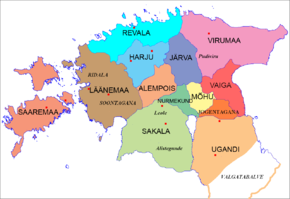Still working to recover. Please don't edit quite yet.
Sackalia
|
| |||||

| |||||
| Capital | Viljandi | ||||
| Elders | Lembitu | ||||
| Independence | 1223 | ||||
Sakala County (Latin: Saccalia, Estonian: Sakala) [1] was an ancient Estonian independent eldership [2], first mentioned in print by Henry of Livonia in the beginning of the 13th Century [3] .
It is situated in north-western Livonia, covering approximately the present territories of Viljandi, the southern half of Pärnu, and a western third of Valga maakond.
Kievan rule of Ugaunia may have lasted until 1061, when, according to Old East Slavic chronicles, the town of Tharbata/Yuryev (Tartu) was burned down by "Sosols", who were probably either Sackalians or the people of Soopoolitse.
After the Livonian Crusade the county became a part of the Livonian Confederation.
In Sackalian folklore, the neighbouring Ugaunians (ugalased) were enemy warriors and robbers. For instance, a folk song from Viljandi (the capital of Sackalia) calls for speeding up the harvest work because Ugaunians might attack. [unverified]
See also[edit]
References[edit]
- ↑ Historical Dictionary of Estonia; p.63 ISBN 0810849046
- ↑ p31, History of Estonia, 2nd Ed., Tõnu Tannberg, et al. AS Bit 2002, ISBN 9985206061
- ↑ The Chronicle of Henry of Livonia; ISBN 0231128894